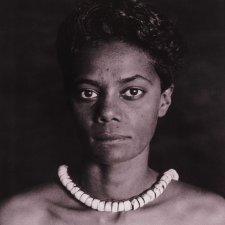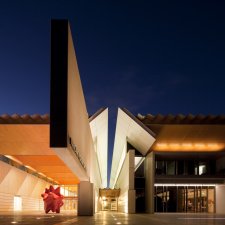- So thank you Annette, for joining me today to have a look at these two beautiful works in Who Are You. The works that I chose are one by Pamela See and this is of Quong Tart, and she made it in 2017. And the other work is by Peter Drew. It's of Monga Khan and the original photograph is from 1916 but the work was made in 2016. The reasons that I chose these two portraits are I was really drawn to them aesthetically. They're both really simple and elegant and beautiful but I think that simplicity gives them power. They both kind of make you stop and have a look. They both have a very kind of neutral colour palette. They're both sort of black and white with this splash of red. So, yeah, they both kind of make you stop. They are both quite powerful works aesthetically. And more than that though I think they really relate to this exhibition. Who are you? Who are we? Who are we as Australians? They both make you stop and think. Yeah, who are we? What was our community back, like, you know, post-colonialism and now who are we today as well? So they're both very powerful in that way. So the first work we'll look at is the one by Pamela See. and I believe she made this for the Portrait Gallery. Is that right?
- Yeah for the Sofi Exhibition.
- Yeah.
- Which was fantastic.
- Yeah.
- Yes.
- And it's 16 works, my understanding. And the one that I've chosen is of Quong Tart. And I really love how, so she's used this ancient Chinese paper cutting technique and also the, like the profile like silhouette portrait which is more European. She's brought those techniques together. And I think that sort of reflects Quong Tart's life because he was born in China and you can actually see that in the portrait. She's used a flower at the top which is the Chinese cotton flower, I think. And that represents his birth in China in Guangdong Province. And then he came out as a boy, I think he was only nine. He was very young. And he came out and he worked as a scribe. And you can see that in a portrait too. When you look along the bottom part of the portrait, you see this feather. And that's, I suppose a pen that he would've scribed with. So I love how Pamela has brought in these the symbols as well to talk about Quong Tart. Should we look at the other one, as well? So the other one we've chosen is of Monga Khan and this is by the artist Peter Drew. And in a similar way to Pamela I think he was very interested in revealing those hidden histories and making you think about what Australia was like pre- the white Australia policy as well. And so he has gone to the National Archives of Australia. He's found images of Australians who were trying to become exempt from the White Australia policy. So these are Australians who come from overseas and who wanted to visit their families. And then when they came back they would have to do this dictation test and they wanted to be exempt from that dictation test. So that's why their photographs within that National Archives. And then Peter Drew has taken these photographs and he's done these beautiful screen prints and he's pasted them around Australia.
- So I remember the first time I saw this poster which was just outside Flinder Station in Melbourne and you see all that other information, advertising billboards and I saw that and I immediately, it sort of shook the way I was looking at it because this beautiful image of a man next to this big print saying Aussie and this juxtaposition was immediately arrested me in my spot. And I think that that was the case for many, many people.
- Yeah. It makes you question, yeah. What does it mean to be an Aussie?
- Yeah.
- Who we are. Who are we? And I know for me, like when you see that you have that personal reaction and you want to find out So you want to research who these people are and how and what, you know, and you find out what the incredible contribution that they made to our community has been and that it's sorry that this history has been lost over time but wonderful how these artists are bringing it back to us.
- Absolutely. Yeah.


















